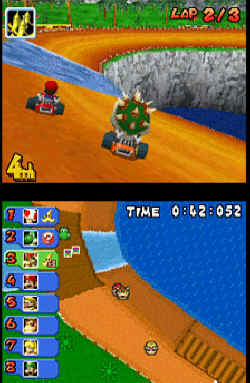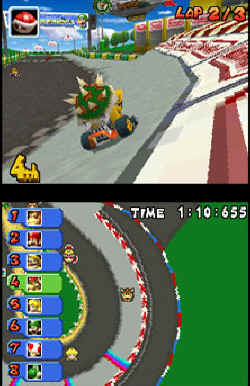 Mario Kart DS doesn't reinvent the genre. Whether or not
there's actually anything left to insert is debatable, and long time fans should be happy.
What this DS entry does is introduce, in a flawed manner, Nintendo's free Wi-Fi service,
and it's hard to think of another Nintendo franchise that would fare better in this
position.
Mario Kart DS doesn't reinvent the genre. Whether or not
there's actually anything left to insert is debatable, and long time fans should be happy.
What this DS entry does is introduce, in a flawed manner, Nintendo's free Wi-Fi service,
and it's hard to think of another Nintendo franchise that would fare better in this
position.It's immediately apparent how refined this fifth game is in the series. The controls are perfect, simplistic to the extreme and accessible to the masses. It's not possible for cornering to feel any easier than this. The eight riders (sadly, only four maximum online) rarely crowd the courses, and these are a mixture of new and old.
If it's so easy, that should put everyone on a level playing field. The introduction and focus on drifting is the change in the series that evolved over time, and it's what separates the newcomers from the experienced players. From the simple to execute drift, there's an opportunity to boost. When done right, it changes the flow of the race. It's also exploitable, and expect to be destroyed by some players online as their cheap tactics push them further into the lead and the only thing that can stop them is luck.
Luck is also the aspect of the game that has become apparent over the years. Yes, there is actual skill involved, but the items that litter the tracks are based on a simple system of catch up. When in the lead, that person will never see any items except a banana peel, fake item box, or a green turtle shell. The person in last will have the full array, including the ridiculously unstoppable bullet bill. This is more apparent here than it ever has been, and doesn't increase the enjoyment of the game's key online features at all.
In single player games, the winner is always chosen too. For each circuit, there are only a few on the roster in contention for the top spot. The rest of the racers lag behind, even if they're stats should be propelling them ahead. This is an obvious compensation for a lack of AI, and much like the multi-player, it comes down to luck of the item draw near the finish line every time out in a tight race.
 What Mario Kart DS has going for it is that Nintendo
feel. Maybe it's been far too many glitchy and convoluted racers over the years, but Mario
Kart is simply right. It's backed by solid design, unmistakable style, and the always
prevalent Nintendo charm. The nods to other games in the vault, from Mario 3 to the SNES
original adds to the appeal for a die hard fan base, though it does make this feel
familiar as it moves on.
What Mario Kart DS has going for it is that Nintendo
feel. Maybe it's been far too many glitchy and convoluted racers over the years, but Mario
Kart is simply right. It's backed by solid design, unmistakable style, and the always
prevalent Nintendo charm. The nods to other games in the vault, from Mario 3 to the SNES
original adds to the appeal for a die hard fan base, though it does make this feel
familiar as it moves on.Besides Wi-Fi play, the single player experience is basic and rather bland. The mission mode is new and a side portion to usual racing in various classes, assigning players tasks like driving through hoops or collecting items. It's a training exercise hidden as a feature. This doesn't help when the online is disappointingly limited, offering no way to communicate, a cut down selection of courses (12 are not available), and you can only race. The battle mode, available via a local connection, would have been perfect for online multi-player. As such, the four player racing matches can grow weary after a while.
There's no question this is a great piece of software for a console that doesn't seem like it can fit anymore. It's also undeniably disappointing in spots, showing its age and flaws quickly. You can't help but think of a sequel with more to offer while playing it. Mario Kart DS isn't the best entry in the franchise, but it's a well constructed Nintendo title, and the type die-hard fans buy the companies products for.